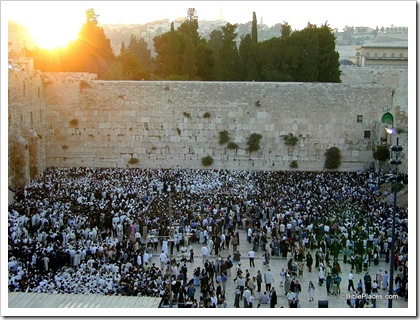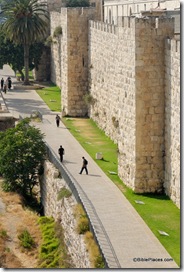Celebration begins tonight of the Feast of Shavuot. Translated in English as “Weeks” and it gets its name from the fact that it begins seven weeks after Passover (Lev 23:15). Shavuot is one of the three great pilgrimage feasts (Deut 16:16), but unlike the week-long celebrations of Passover and Tabernacles, this one is observed for one day only. Modern celebration of Shavuot consists of all-night study of the Scriptures, especially Ruth, and consuming dairy products. Arutz-7 reports:
Jewish men and women in Israel will join their brethren around the world to learn all night Tuesday, although in Israel the holiday is observed for only one day. Many will also be eating dairy foods and putting greenery in their homes and synagogues, all in the name of observing the Shavuot holiday.
The practice of learning all night is a custom, rather than a commandment, and is the expression of one’s desire to draw closer to G-d. It also is carried out to counter the behavior of the Jews who slept at Mount Sinai instead of waiting for the giving of the Torah. By staying up the entire night and studying, their descendants strive to rectify the slight caused to the honor of the Torah.
[…]
As always, prayers and learning are being held through the night at the Western Wall (the Kotel). Jerusalem hotels are packed to capacity as tourists who remember past years, and those who have been told of its beauty, wait with anticipation for the event. Right before dawn, one can see tens of thousands making their way to the Wall for early morning prayer service.
The full article is here, and more information about this holiday is available at JewFAQ.org and Wikipedia.
Shortly after Jesus’ resurrection, the disciples were gathered in Jerusalem for the Feast of Shavuot, also known as Pentecost. It was at this time that the Holy Spirit came upon them and they spoke in many languages. Jews from all over the world were there to hear them because they were obedient to go up to Jerusalem for the feast. You can read more about this event in Acts 2.
Acts 2:5-12 (NIV) “Now there were staying in Jerusalem God-fearing Jews from every nation under heaven. When they heard this sound, a crowd came together in bewilderment, because each one heard them speaking in his own language. Utterly amazed, they asked: “Are not all these men who are speaking Galileans? Then how is it that each of us hears them in his own native language? Parthians, Medes and Elamites; residents of Mesopotamia, Judea and Cappadocia, Pontus and Asia, Phrygia and Pamphylia, Egypt and the parts of Libya near Cyrene; visitors from Rome (both Jews and converts to Judaism); Cretans and Arabs—we hear them declaring the wonders of God in our own tongues!” Amazed and perplexed, they asked one another, “What does this mean?””


